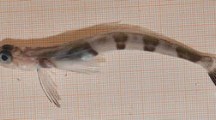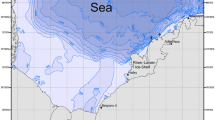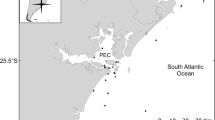Abstract
The Antarctic plunderfishes (Artedidraconidae) are a poorly known component of the bottom fish fauna inhabiting the continental shelf of the High Antarctic Zone. Biological data on these fishes are still rather scarce and generally based on only a few specimens. To increase the knowledge of this group, we investigated the reproductive biology and population age structure of Artedidraco skottsbergi and Dolloidraco longedorsalis, the most abundant plunderfishes collected during the 2013/2014 expedition of the RV Polarstern in the Weddell Sea. Based on macroscopic and histological analyses, we found that both species exhibited prolonged gametogenesis and produced few eggs. Estimates of absolute and relative fecundity were lower in A. skottsbergi than in D. longedorsalis, ranging from 69 ± 7 oocytes per female and 11.4 ± 4.3 oocytes/g, and from 209 ± 73 oocytes per female and 13.5 ± 3.7 oocytes/g, respectively. Female size at first spawning was estimated to be 9.5 and 11 cm in A. skottsbergi and D. longedorsalis, respectively. Age and growth were assessed through otolith readings, and estimates of age ranged between 6 and 14 years in A. skottsbergi and between 3 and 14 years in D. longedorsalis. The von Bertalanffy growth parameters were only estimated for D. longedorsalis (L ∞ = 12.5 cm, k = 0.27, t 0 = −0.06). The results of this study provide insights into some of the biological aspects of these species and shed new light on their life strategies, which show similarities to those of other notothenioids.






Similar content being viewed by others
References
Balushkin A, Eakin R (1998) A new toad plunderfish Pogonophryne fusca sp. nova (fam. Artedidraconidae: Notothenioidei) with notes on species composition and species groups in the genus Pogonophryne Regan. J Ichthyol 38:574–579
Beamish RJ, Fournier DA (1981) A method of comparing the precision of a set of age determinations. Can J Fish Aquat Sci 38:982–983
Billard R (1986) Spermatogenesis and spermatology of some teleost fish species. Reprod Nutr Dev 26:877–920
Chang WYB (1982) A statistical method for evaluating the reproducibility of age determination. Can J Fish Aquat Sci 39:1208–1210
Christiansen JS, Fevolden SE, Karamushko OV, Karamushko LI (1998) Maternal output in polar fish reproduction. In: Di Prisco G, Pisano E, Clarke A (eds) Fishes of Antarctica. A biological overview. Springer, Milan, pp 41–52
Daniels RA (1978) Nesting behaviour of Harpagifer bispinis in Arthur Harbour, Antarctic Peninsula. J Fish Biol 12:465–474
Daniels RA (1982) Feeding ecology of some fishes of the Antarctic Peninsula. Fish Bull 80:575–588
Duarte CM, Alcaraz M (1989) To produce many small or few large eggs: a size-independent reproductive tactic of fish. Oecologia 80:401–404
Duhamel G, Kock K-H, Balguerias E, Hureau J-C (1993) Reproduction in fish of the Weddell Sea. Polar Biol 13:193–200
Eakin RR, Eastman JT, Jones CD (2001) Mental barbel variation in Pogonophryne scotti Regan (Pisces: Perciformes: Artedidraconidae). Antarct Sci 13:363–370
Eastman JT (1993) Antarctic fish biology: evolution in an unique environment. Academic Press, San Diego
Eastman JT, Eakin RR (2000) An updated species list for notothenioid fish (Perciformes; Notothenioidei), with comments on Antarctic species. Arch Fish Mar Res 48:11–20
Eastman JT, Eakin RR (2001) Mental barbel and meristic variation in the Antarctic notothenioid fish Dolloidraco longedorsalis (Perciformes: Artedidraconidae) from the Ross Sea. Polar Biol 24:729–734
Eastman JT, Hubold G (1999) The fish fauna of the Ross Sea, Antarctica. Antarct Sci 11:293–304
Eastman JT, Lannoo MJ (2003) Diversification of brain and sense organ morphology in Antarctic dragonfishes (Perciformes: Notothenioidei: Bathydraconidae). J Morphol 258:130–150
Ekau W (1991) Reproduction in high Antarctic fishes (Notothenioidei). Meeresforsch 33:159–167
Everson I (1984) Fish biology. In: Laws RM (ed) Antarctic ecology, vol 2. Academic Press, London, pp 491–532
Gutt J, Ekau W (1996) Habitat partitioning of dominant high Antarctic demersal fish in the Weddell Sea and Lazarev Sea. J Exp Mar Biol Ecol 206:25–37
Hubold G (1991) Ecology of notothenioid fish in the Weddell Sea. In: Di Prisco G, Maresca B, Tota B (eds) Biology of Antarctic fish. Springer Science and Business Media, Berlin, pp 3–22
Hubold G (1992) Ecology of Weddell sea fishes. Ber Polarforsch 103:1–157
Iwami T, Numanami H, Yasuhiko N (1996) Behavior of three species of the family Artedidraconidae (Pisces, Notothenioidei), with reference to feeding. Proc NIPR Symp Polar Biol 9:225–230
Janssen J, Jones W, Slattery M (1993) Locomotion and feeding responses to mechanical stimuli in Histiodraco velifer (Artedidraconidae). Copeia 3:885–889
Jones C, Near T (2012) The reproductive behaviour of Pogonophryne scotti confirms widespread egg-guarding parental care among Antarctic notothenioids. J Fish Biol 80:2629–2635
Kamler E (1992) Early life history of fish: an energetics approach. Chapman & Hall, London
Knust R, Schröder M (2014) The expedition PS82 of the research vessel POLARSTERN to the southern Weddell Sea in 2013/2014. Ber Polarforsch 680:1–155
Kock KH (1989) Reproduction in fish around Elephant Island. Arch FischWiss 39:171–210
Kock K-H, Kellermann A (1991) Reproduction in Antarctic notothenioid fish. Antarct Sci 3:125–150
La Mesa M, Caputo V, Rampa R, Vacchi M (2003) Macroscopic and histological analyses of gonads during the spawning season of Chionodraco hamatus (Pisces, Channichthyidae) off Terra Nova Bay, Ross Sea, Southern Ocean. Polar Biol 26:621–628
La Mesa M, Caputo V, Rampa R, Eastman JT (2006) Gametogenesis in the Antarctic plunderfishes Artedidraco lönnbergi and Artedidraco skottsbergi (Pisces: Artedidraconidae) from the Ross Sea. Antarct Sci 18:183–190
Macchi G, Barrera-Oro E (1995) Histological study on the ovarian development of mackerel icefish (Champsocephalus gunnari) from the South Georgia Islands. CCAMLR Sci 2:35–49
Macdonald J, Montgomery J (1991) The sensory biology of notothenioid fish. In: Di Prisco G, Maresca B, Tota B (eds) Biology of Antarctic Fish. Springer Science and Business Media, Berlin, pp 145–162
Morales-Nin B, Moranta J, Balguerias E (2000) Growth and age validation in high-Antarctic fish. Polar Biol 23:626–634
Munro JL, Pauly D (1983) A simple method for comparing the growth of fishes and invertebrates. ICLARM Fishbyte 1:5–6
Murua H, Kraus G, Saborido-Rey F, Witthames PR, Thorsen A, Junquera S (2003) Procedures to estimate fecundity of marine fish species in relation to their reproductive strategy. J Northwest Atl Fish Sci 33:33–54
Nagahama Y (1983) The functional morphology of teleost gonads. Fish Physiol 9:223–275
North AW, White MG (1987) Reproductive strategies of Antarctic fish. In: Kullander S, Fernholm B (eds) Proceedings of the V congress of the European Ichthyological Society, Stockholm 1985. Swedish Museum of Natural History, pp 381–390
Olaso I, Rauschert M, De Broyer C (2000) Trophic ecology of the family Artedidraconidae (Pisces: Osteichthyes) and its impact on the eastern Weddell Sea benthic system. Mar Ecol Prog Ser 194:143–158
Pearse AGE (1985) Histochemistry. Theoretical and applied analytical technology. Churchill Livingstone, Edinburgh
Schwarzbach W (1988) The demersal fish fauna of the eastern and southern Weddell Sea: geographical distribution, feeding of fishes and their trophic position in the food web. Ber Polarforsch 54:1–93
Smith CC, Fretwell SD (1974) The optimal balance between size and number of offspring. Am Nat 108(962):499–506
Stearns SC (1989) Trade-offs in life-history evolution. Funct Ecol 3:259–268
Stearns SC (1992) The evolution of life histories. Oxford University Press, Oxford
Voskoboinikova O (2001) Juveniles of five species of Antarctic notothenioid fishes from the Weddell Sea. J Ichthyol 27:397–400
Wallace RA, Selman K (1981) Cellular and dynamic aspects of oocyte growth in teleosts. Am Zool 21:325–343
West G (1990) Methods of assessing ovarian development in fishes: a review. Mar Freshw Res 41:199–222
White MG (1991) Age determination in Antarctic fish. In: Di Prisco G, Maresca B, Tota B (eds) Biology of Antarctic fish. Springer, Berlin, pp 87–100
White M, Burren P (1992) Reproduction and larval growth of Harpagifer antarcticus Nybelin (Pisces, Notothenioidei). Antarct Sci 4:421–430
Witthames PR, Thorsen A, Murua H, Saborido-Rey F, Greenwood LN, Dominguez R, Korta M, Kjesbu OS (2009) Advances in methods for determining fecundity: application of the new methods to some marine fishes. Fish Bull 107:148–164
Acknowledgments
We wish to thank all of the crew members and personnel aboard the R/V Polarstern on the PS 82 2014 expedition, for their essential support during the samplings activities and special thanks to the fish team composed of Rainer Knust (Chief Scientist), Chiara Papetti, Nils Koschnick, Kai Wätjen, Maj Wetjen and Massimiliano Babbucci. We are also grateful to Anton Van de Putte and two anonymous referees, who provided helpful comments on the manuscript. This work was financially supported by the Programma Nazionale di Ricerche in Antartide (PNRA) and MIUR grants.
Author information
Authors and Affiliations
Corresponding author
Rights and permissions
About this article
Cite this article
Meneghesso, C., Riginella, E., La Mesa, M. et al. Age and reproduction in two Antarctic plunderfishes (Artedidraconidae) from the Weddell Sea. Polar Biol 40, 13–24 (2017). https://doi.org/10.1007/s00300-016-1919-9
Received:
Revised:
Accepted:
Published:
Issue Date:
DOI: https://doi.org/10.1007/s00300-016-1919-9




